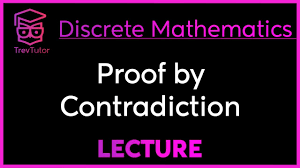Proof by Contradiction Explained

Proof by contradiction is a common technique used to prove a statement by assuming the negation of the statement and demonstrating that this assumption leads to a contradiction. Here's a step-by-step guide on how to do a proof by contradiction:
1. Start with the statement you want to prove. Suppose it is denoted as "P."
2. Assume the negation of the statement, denoted as "not P," is true.
3. Proceed with logical reasoning, deductions, or calculations based on the assumption that "not P" is true.
4. Show that the assumption of "not P" leads to a contradiction with established facts, known truths, or previously proven statements.
5. The contradiction implies that the assumption of "not P" cannot be true.
6. Therefore, the original statement "P" must be true.
To summarize, in a proof by contradiction, you assume the negation of the statement you want to prove and then derive a contradiction from that assumption. This contradiction establishes the truth of the original statement. By showing that the negation leads to an inconsistency, you conclude that the original statement must be true.
Why Use Proof by Contradiction?
Proofs by contradiction are a powerful technique used in mathematics to establish the truth of a statement. Here are some reasons why we use proofs by contradiction:
1. Assumption of the opposite: In a proof by contradiction, we assume the opposite of what we want to prove. By assuming the negation of the statement and deriving a contradiction, we can conclude that our original assumption was incorrect and therefore the statement must be true.
2. Reduction to absurdity: By assuming the opposite and deriving a contradiction, we show that the negation of the statement leads to an absurd or contradictory result. This demonstrates the inconsistency or impossibility of the opposite statement, reinforcing the truth of the original statement.
3. Simplification of the proof process: In some cases, proving a statement directly may be complex or involve multiple cases. By using a proof by contradiction, we can often simplify the proof process by focusing on a single assumption and deriving a contradiction from it.
4. Strategy for proving existence statements: Proofs by contradiction are commonly used to establish the existence of certain mathematical objects or solutions. By assuming the non-existence of the object or solution and arriving at a contradiction, we can show that the object or solution must indeed exist.
5. Application in various branches of mathematics: Proofs by contradiction are employed in various branches of mathematics, including number theory, geometry, algebra, analysis, and more. They provide a versatile tool for establishing the truth of statements in different mathematical contexts.
It's important to note that while proofs by contradiction can be effective, they are not always the preferred method of proof. In some cases, more direct or constructive proofs may be available and provide a clearer understanding of the underlying concepts.